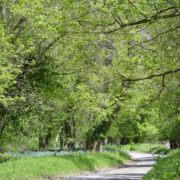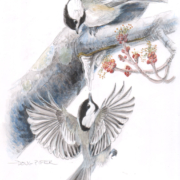This is Our Boyce Volunteer Fire Company
By Cathy Kuehner, Clarke County
Editor’s Note: This is the first in a three-part series highlighting Clarke County’s volunteer fire companies: Boyce Volunteer Fire Company, Blue Ridge Volunteer Fire and Rescue Company, and John H. Enders Fire Company & Rescue Squad. All need volunteers — firefighters and EMTs to run calls and individuals to help with events and fundraising — and all need the support of the entire community.
When lifelong county resident Lee Coffelt was 16, he joined his hometown volunteer fire company as soon as he was eligible. Recalling his volunteer training long ago, Coffelt said, “I was shown how to wear the gear, how to wear an air pack, how to follow a hose in the dark, and how to handle a hose and spray water. And someone said, ‘OK, you’re good to go.’” Today, volunteer firefighters receive hundreds of hours of specialized training, and the equipment — from the gear they wear to the apparatus they use — has also changed significantly over the decades.
Coffelt joined the Boyce Volunteer Fire Company in 1984. He became its chief eight years ago.
“The other big difference is that the work used to be all about fighting fires,” said Coffelt. “Now, fires are the least of it. The majority of calls are for EMS.”
Of the calls for emergency medical services, Coffelt noted, most are to homes and senior care facilities. “Some EMS calls are for auto accidents, but safety features in cars have improved over the years, greatly reducing the number of injuries and fatalities.”
According to the Clarke County Fire-Rescue 2020 Annual Report, the Boyce Volunteer Fire Company last year responded to 57 fire alarms, 10 structure fires, and 1 woodland fire. It responded to 78 motor vehicle accidents. As Coffelt said, EMS calls are greater. Last year, Boyce VFC responded to 42 breathing problems, 39 chest pain calls, 41 falls, 17 strokes, 14 incidents of cardiac arrest, and 2 overdoses.
Regardless of the number of calls, the response time is much more important to all the volunteers. Currently, Boyce has 25 operational members who can run calls, and 25 administrative members who handle a variety of tasks, including fundraising. Because of work, distance, or other obligations, not everyone is available all the time.
Ideally, Coffelt said, there should be 50 operational members trained to run calls and 50 administrative volunteers. “If we could double our roster of good people who consistently show up, we could get to the next level of getting first responders and apparatus out the door within minutes of a call.” Coffelt noted, “Clarke County is still the only jurisdiction in the region where the majority of service is provided by volunteers.”
He says this with both pride and hope that people will continue to step up to help their neighbors. Training is provided at no cost for community members interested in volunteering, and Clarke County offers a 50 percent personal property tax discount for any county resident who volunteers with a fire company.
The idea of a Boyce volunteer fire company began in April 1959, when its residents recognized that nearly half of all fires occurred in the southern half of the county. Community fundraising followed. By July 1959, a $500 fire siren was installed on an old building, and the newly formed Boyce Volunteer Fire Company kept its first firetruck in the gas station across from where the firehouse sits today on U.S. 340. The community continued to raise money for a fire hall, which opened in March 1961 with its siren relocated to the building, and community members continue to help raise much-needed funds.
“The fundraising that began in 1959 laid the foundation for how we still conduct business as a nonprofit organization,” Coffelt said. “We do not want to be a financial burden to
taxpayers or the county.” While Boyce VFC does receive annual funding from Clarke County, over half its annual revenues come from fundraising efforts. Weekly bingo games at the social hall on Thursday evenings and Sunday afternoons are a major fundraising source for the fire company. In addition, rentals of the social hall, chicken dinners, a fall bazaar, and individual donations all contribute to covering operational costs.
Boyce Volunteer Fire Company President Matt Hoff explained, “Running a fire company is an expensive endeavor.” Boyce is currently paying down debt owed for the social hall, which is in addition to standard operating costs such as electricity, phone, and water. The company’s next big expense will be a new pumper truck. A fire truck can cost in excess of $600,000 and an ambulance more than $250,000.
So, after 37 years, why does Coffelt continue to volunteer and run calls? “I believe in our mission — community members providing critical services to their neighbors in their time of need. I am totally behind that.”
Read more Boyce Volunteer Fire Company history in John Hudson’s book, “Welcome to Boyceville,” which is available at Boyce Town Hall. Find Clarke County’s 2020 Fire & EMS Annual Report at clarkecounty.gov. For more information about volunteering, donating, or fundraising events, follow Boyce Volunteer Fire Company on Facebook, or contact the Boyce VFC at (540) 837-1228 or bvfctreas@gmail.com.









